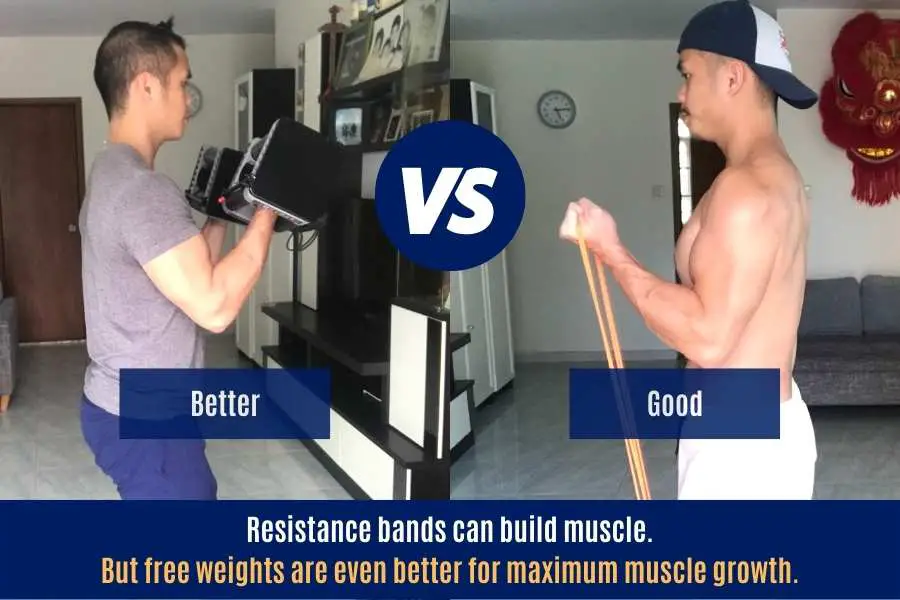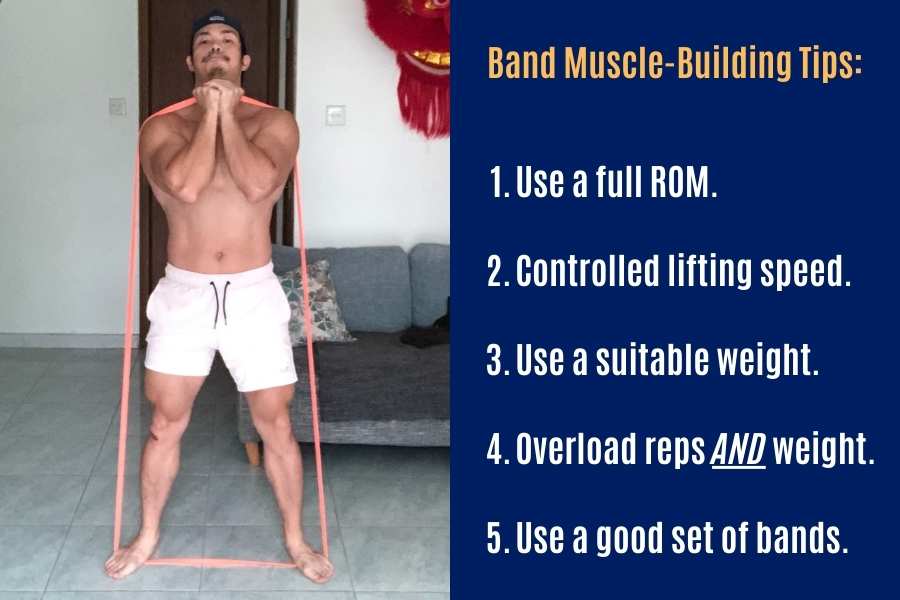Most of us are interested in training and adding lean mass to our bodies. But choosing the BEST WAY to train can be a difficult and frustrating experience. This post explains whether or not resistance bands build muscle as well as weights.
Overall, resistance bands do not build muscle as well as weights. However, bands can still be effectively used by untrained beginners to put on lean muscle. Experienced lifters usually find free weights to be more effective for maximizing muscle growth and strength gains.
Why can you trust this article?
Well, I’m not a Pro.
But I do have 10 years of experience using weights at the gym as well as resistance bands at home.
Below, I share my experience and research to help you decide which is better!

- Can Resistance Bands Build Muscle Like Weights?
- Why Resistance Bands Cannot Build As Much Muscle As Weights
- Ways Resistance Bands Can Work Better Than Weights
- Resistance Band Effectiveness Compared To Weights For Different Bodyparts
- Tips To Use Resistance Bands Instead Of Weights For Building Muscle
- Conclusion
Can Resistance Bands Build Muscle Like Weights?
Resistance bands can build muscle like weights. They provide an external resistance for muscles to work against. Bands provide linear variable resistance and free weights provide constant resistance. Both types of stimuli are effective for promoting muscle growth in beginners.

How does external resistance promote muscle growth?
To put it simply, microdamage occurs in the muscle when it is challenged with a significant amount of opposing force (i.e. resistance) to fight against.
And the subsequent repair process causes the muscles to grow back bigger and stronger.

Now, both bands AND free weights can produce a significant amount of resistance.
But they vary in the type of resistance produced:
- Bands give linear variable resistance (LVR). Weight increases as the band stretch longer across the range of motion. In a bicep curl example, this means the intensity is greatest at the top of the movement.
- Weights give constant resistance (CR). Weight remains the same across the range of motion. In a bicep curl example, this means the intensity is greatest in the lower-middle portion of the movement where the dumbbell puts the greatest demand on the biceps.
Both types of resistance- if large enough- will promote muscle growth; especially in beginners.
However, this 2016 study indicates that bands may be inferior to weights for building muscle in trained individuals.
Therefore bands and weights can both effectively build muscle in beginners.
But weights are likely to be better than bands when it comes to muscle gains in intermediates and above.
Why Resistance Bands Cannot Build As Much Muscle As Weights
Resistance bands are unlikely to build as much muscle as weights can. Free weights can be loaded with heavier resistances than bands and it is also easier to progressive overload using free weights than it is using resistance bands. Progressive overload is key to muscle growth.

Put simply- yes, resistance bands can build muscle. But it’s unlikely you’ll build AS MUCH muscle as you could with weights.
Here are the detailed reasons why most people can’t gain as much muscle with bands compared to weights:
1) Bands cannot be loaded with as much weight.
Heavy bands CAN provide extremely high amounts of resistance on paper.
But they’re also very unstable and it requires immense core strength to use heavy bands properly.
Most people do not have this.
As such, bands are limited in how much weight you can realistically use. Weights in comparison are easier to load heavily.
2) Bands have unprecise weights.
They’re crudely labeled as light/medium/heavy and sometimes have a weight range. But resistance is imprecise and changes as the band stretch.
This means you don’t necessarily know how much weight you’re using, unlike free weights where you always know precisely what weight you’re lifting.
And knowing exactly how much you’re lifting is essential for progressive overload which is a key driver for muscle growth (see next point).
3) It is hard to progressive overload with bands.
This is essential for gaining muscle and refers to the act of increasing exercise intensity over time. Overloading is usually achieved by incrementally increasing weight.
It’s difficult to overload properly with bands since you don’t know the precise weight being lifted.
In comparison, overloading is easy with weights; just move up to the next dumbbell or add another plate onto the barbell.
4) It is harder to stay motivated with bands.
Building muscle requires consistent training over many months.
This 2022 study found that seeing a measurable progression path can help with sticking to your routine. Bands do not always have a clear progression path since you don’t know the exact weight being lifted. This is unlike weights where you can see clear improvement over time (i.e. moving from a 10lb to a 15lb dumbbell).
Thus, most people find it easier to stick to a weight routine than aband routine. And these people will usually build more muscle.
If you like, you ucan check out my other post for a detailed comparison between bands vs dumbbells and which is better.
Ways Resistance Bands Can Work Better Than Weights
Resistance bands can work better than weights for beginners. They are cheap, convenient, portable, and produce a good amount of resistance. This makes them ideal for moderate muscle-building. However, weights are superior for outright muscle-building potential.

My opinion is this:
Weights are generally better than bands for experienced lifters and those looking for max muscle gains. But bands can be better than weights for beginners due to their sheer convenience.
Here’s why resistance bands can be better than weights for a beginner:
- Bands are cheaper. You can’t beat the cost-effectiveness of using resistance bands vs going to the gym. A good quality set of bands can also be bought at a fraction of the price you’d pay for free weights.
- Bands are more convenient. Bodyweight training is the easiest way to work out anytime and anywhere. And resistance bands make bodyweight exercises more effective!
- Bands provide sufficient resistance. Resistance bands may not be as effective as free weights for outright muscle-building potential, but they’re by no means a walk in the park either. They can give beginners and most intermediate-advanced lifters a good workout.
- Bands are great for isolation exercises. These are small exercises like the bicep curl, lateral raise, leg curl, and ab crunch. They work single muscles at a time and are great for defining specific muscles. This makes resistance bands great for building muscle and tone in specific body parts (see next section).
Thus, your personal needs and goals determine whether resistance bands can work better for you than weights.
As a beginner who wants to start building muscle, bands can be awesome.
Even experienced lifters may find the sheer convenience of resistance bands a great way to maintain their current muscle mass.
Resistance Band Effectiveness Compared To Weights For Different Bodyparts
It’s important to consider what muscles you’re looking to build when asking if resistance bands are better than weights.
Most people will agree that free weights are the best way to target large muscle groups and train for overall body mass.
But resistance bands can be more effective at targeting smaller muscles to increase definition.
Here’s how bands compare to weights for building muscle in different body regions:
| Bodypart | Muscles | Bands Or Weights Better For Building Muscle? | Reason |
|---|---|---|---|
| Chest | Pectorals | Weights | Large muscle groups respond better to heavy loading using compound exercises like the chest press. |
| Shoulders | Deltoids | Similar | Small muscle groups respond better to lighter loading using isolation exercises like the lateral raise (heavy compound shoulder pressing is also effective). |
| Back | Trapezius, rhomboids, latissimus dorsi | Weights | Large muscle groups respond better to heavy loading using compound exercises like the row. |
| Arms | Biceps, triceps | Similar | Small muscle groups respond better to lighter loading using isolation exercises like the bicep curl or tricep extension. |
| Abs | Abdominals, obliques | Similar | Small muscle groups respond better to lighter loading using isolation exercises like the ab crunch or core rotation. |
| Legs | Quadriceps, hamstrings, calves, glutes | Weights | Large muscle groups respond better to heavy loading using compound exercises like the squat and deadlift. |
Thus, bands can be better for isolation-type movements like bicep curls to increase muscle definition.
And weights are generally better for compound-type movements like the bench press to build overall muscle mass.
If you like, you can check out my resistance band workout to get ripped!
Tips To Use Resistance Bands Instead Of Weights For Building Muscle
I’ve been using resistance bands for over 5 years now.

Here are my top tips on how to use resistance bands instead of weights to build muscle:
- Use a full range of motion (ROM). Bands produce the most resistance at their maximal stretch. Therefore it’s important to go through the full ROM when using bands. In a bicep curl example, the elbow should fully extend at the bottom of the exercise and fully flex at the top of the exercise.
- Control lifting speed. Go. Slow. Each rep should last at least 4 seconds (2 seconds up and 2 seconds down). Preferably 6 seconds if you can handle it! The burn can be unbearable, but trust me, you’ll get an awesome muscle pump!
- Choose a suitable weight. The band should be heavy enough to induce muscular fatigue by the last few reps, but light enough to allow you to do the previous two points (full ROM and controlled lifting speed). Use trial and error to find the ideal weight!
- Progressive overload with reps AND weight. It can be hard to progressive overload with weight when using bands because you don’t know exactly how much weight you are lifting. Try overloading with reps instead. Do this by increasing reps every week. I’d avoid exceeding 15 reps per set though. If 15 reps become too easy, it’s time to increase weight.
- Get a good set of bands. These will give you enough weight increments to progressive overload. A minimum of 3 high-quality bands with different weights (light, medium, heavy) are recommended. 5 bands are advised for best results (extra light, light, medium, heavy, extra heavy).
Conclusion
Hopefully, I’ve helped clarify whether resistance bands build muscle as well as weights.
Beginners will usually find bands can be just as effective as weights for building muscle.
But the difference in effectiveness increases with training experience.
Intermediates and advanced lifters will usually find free weights to be more effective than bands for building muscle.
That’s because weights allow you to more easily lift heavy weights and progressive overload more effectively.
Will you be using resistance bands or weights to build muscle?
Feel free to send me a message if you have any questions! You can find my details on the “contact us” page.
You may also be interested in the downloadable Kalibre Blueprint PDF which details exactly how I gained 40lbs of lean muscle (it’s 100% free!). It details the exact exercises and nutrition (with printable worksheets) I used to go from skinny to ripped!
Thanks for reading guys!
Peace Out,
Kal
(Biochemistry BSc, Biomedical Sciences MSc, Ex-Skinny Guy)


